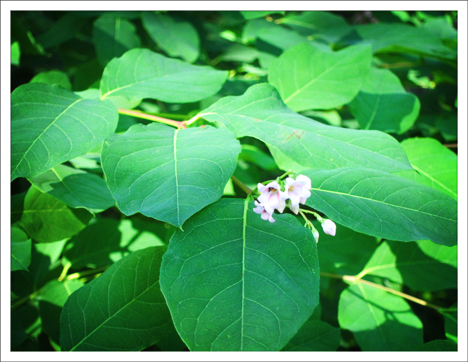Adirondack Wildflowers:
Spreading Dogbane (Apocynum androsaemifolium)
 Adirondack Wildflowers: Spreading Dogbane at the Paul Smiths VIC (23 June 2012)
Adirondack Wildflowers: Spreading Dogbane at the Paul Smiths VIC (23 June 2012)
| This page is no longer being updated. For an updated and expanded version of this material, see: Spreading Dogbane (Apocynum androsaemifolium) |
Spreading Dogbane is an Adirondack wildflower which sports clusters of fragrant, bell-shaped pink flowers in late June and July. The flowers are 3/8 inch long, with five small triangular lobes and a corolla with five spreading, recurved triangular lobes. The inside of the flower has deep rose markings. The flowers are said to attract butterflies and bees. The stems and leaves of the Spreading Dogbane plant, when broken, exude a milky sap.
The plant is also called Bitterroot (a reference to the bitterness of the roots) and Flytrap Dogbane. The Genus name "Apocynum" is from the Greek for "away from dog." This is a reference to the fact that the plant is poisonous to dogs.
A related plant -- Intermediate Dogbane -- has paler pink or white flowers, and the lobes are not recurved. Another related plant -- Indian Hemp -- has smaller white or greenish-white flowers.
Spreading Dogbane grows in open to lightly shaded sites in old fields and along the edges of woods. It is common throughout northern New York and the northern portions of North America.
All parts of the plant are poisonous, although native North American Indians reportedly employed it to treat a wide variety of complaints including headaches, convulsions, earache, heart palpitations, colds, and dizziness. The women of some native American tribes used dogbane stem fibers (best harvested in the fall) to make fine thread, used for sewing and for making twine, nets, fabric, and bowstrings.
 Adirondack Wildflowers: Spreading Dogbane at the Paul Smiths VIC (5 July 2011)
Adirondack Wildflowers: Spreading Dogbane at the Paul Smiths VIC (5 July 2011)
Spreading Dogbane may be observed on several trails at the Paul Smiths VIC (including the Barnum Brook Trail). It also grows profusely near the VIC building. Spreading Dogbane usually begins blooming in June.
References
- Lady Bird Johnson Wildflower Center. Native Plant Database.
- United States Department of Agriculture. Plants Database.
- Plants for a Future. Database.
- Doug Ladd. North Woods Wildflowers (Falcon Publishing, 2001), p. 68.
- Lawrence Newcomb. Newcomb's Wildflower Guide (Little Brown and Company, 1977), pp. 250-251.
- Roger Tory Peterson and Margaret McKenny. A Field Guide to Wildflowers. Northeastern and North-central North America (Houghton Mifflin Company, 1968), pp. 292-293.
- William K. Chapman, et al. Wildflowers of New York in Color (Syracuse University Press, 1998), pp. 58-59.
- National
Audubon Society. Field Guide to Wildflowers. Eastern Region.
(Alfred A. Knopf, 2001), pp. 346-347.
